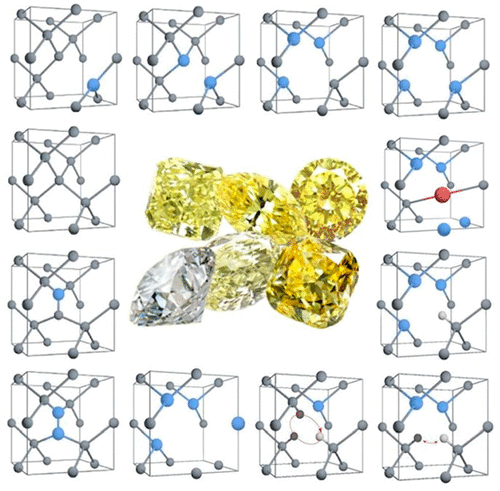当前位置:
X-MOL 学术
›
Chem. Rev.
›
论文详情
Our official English website, www.x-mol.net, welcomes your feedback! (Note: you will need to create a separate account there.)
Nitrogen in Diamond.
Chemical Reviews ( IF 62.1 ) Pub Date : 2020-02-12 , DOI: 10.1021/acs.chemrev.9b00518 Michael N R Ashfold 1 , Jonathan P Goss 2 , Ben L Green 3 , Paul W May 1 , Mark E Newton 3 , Chloe V Peaker 4
Chemical Reviews ( IF 62.1 ) Pub Date : 2020-02-12 , DOI: 10.1021/acs.chemrev.9b00518 Michael N R Ashfold 1 , Jonathan P Goss 2 , Ben L Green 3 , Paul W May 1 , Mark E Newton 3 , Chloe V Peaker 4
Affiliation

|
Nitrogen is ubiquitous in both natural and laboratory-grown diamond, but the number and nature of the nitrogen-containing defects can have a profound effect on the diamond material and its properties. An ever-growing fraction of the supply of diamond appearing on the world market is now lab-grown. Here, we survey recent progress in two complementary diamond synthesis methods—high pressure high temperature (HPHT) growth and chemical vapor deposition (CVD), how each is allowing ever more precise control of nitrogen incorporation in the resulting diamond, and how the diamond produced by either method can be further processed (e.g., by implantation or annealing) to achieve a particular outcome or property. The burgeoning availability of diamond samples grown under well-defined conditions has also enabled huge advances in the characterization and understanding of nitrogen-containing defects in diamond—alone and in association with vacancies, hydrogen, and transition metal atoms. Among these, the negatively charged nitrogen-vacancy (NV–) defect in diamond is attracting particular current interest in account of the many new and exciting opportunities it offers for, for example, quantum technologies, nanoscale magnetometry, and biosensing.
中文翻译:

钻石中的氮。
天然钻石和实验室钻石中都普遍存在氮,但是含氮缺陷的数量和性质会对钻石材料及其性能产生深远影响。现在,在世界市场上出现的钻石供应量中不断增长的一部分已经由实验室种植。在这里,我们调查了两种互补的金刚石合成方法(高压高温(HPHT)生长和化学气相沉积(CVD))的最新进展,每种方法如何更精确地控制所得金刚石中的氮掺入以及金刚石的生产方式可以通过任何一种方法进一步处理(例如,通过植入或退火)以获得特定的结果或性质。在定义明确的条件下生长的金刚石样品的迅速增长的可用性,也使得在表征和理解金刚石中的含氮缺陷方面取得了巨大进展,无论是单独还是与空位,氢和过渡金属原子有关。其中,带负电荷的氮空位(NV–)由于钻石为量子技术,纳米级磁力测定法和生物传感等领域提供了许多令人兴奋的新机遇,因此钻石的缺陷正引起当前的特别关注。
更新日期:2020-02-12
中文翻译:

钻石中的氮。
天然钻石和实验室钻石中都普遍存在氮,但是含氮缺陷的数量和性质会对钻石材料及其性能产生深远影响。现在,在世界市场上出现的钻石供应量中不断增长的一部分已经由实验室种植。在这里,我们调查了两种互补的金刚石合成方法(高压高温(HPHT)生长和化学气相沉积(CVD))的最新进展,每种方法如何更精确地控制所得金刚石中的氮掺入以及金刚石的生产方式可以通过任何一种方法进一步处理(例如,通过植入或退火)以获得特定的结果或性质。在定义明确的条件下生长的金刚石样品的迅速增长的可用性,也使得在表征和理解金刚石中的含氮缺陷方面取得了巨大进展,无论是单独还是与空位,氢和过渡金属原子有关。其中,带负电荷的氮空位(NV–)由于钻石为量子技术,纳米级磁力测定法和生物传感等领域提供了许多令人兴奋的新机遇,因此钻石的缺陷正引起当前的特别关注。



























 京公网安备 11010802027423号
京公网安备 11010802027423号